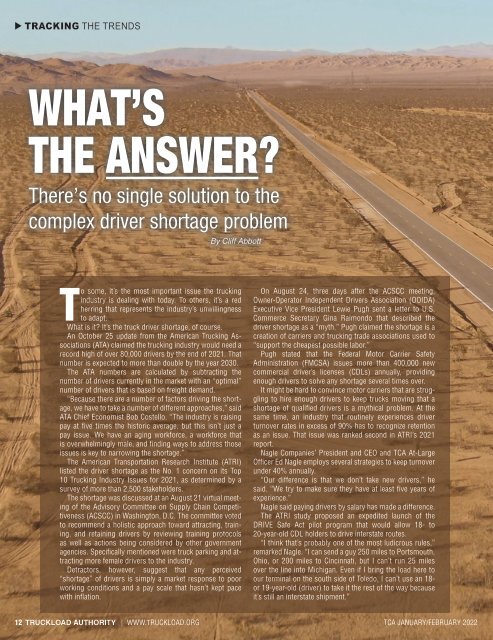Create successful ePaper yourself
Turn your PDF publications into a flip-book with our unique Google optimized e-Paper software.
TRACKING THE TRENDS<br />
WHAT’S<br />
THE ANSWER?<br />
There’s no single solution to the<br />
complex driver shortage problem<br />
By Cliff Abbott<br />
To some, it’s the most important issue the trucking<br />
industry is dealing with today. To others, it’s a red<br />
herring that represents the industry’s unwillingness<br />
to adapt.<br />
What is it? It’s the truck driver shortage, of course.<br />
An October 25 update from the American Trucking Associations<br />
(ATA) claimed the trucking industry would need a<br />
record high of over 80,000 drivers by the end of 2021. That<br />
number is expected to more than double by the year 2030.<br />
The ATA numbers are calculated by subtracting the<br />
number of drivers currently in the market with an “optimal”<br />
number of drivers that is based on freight demand.<br />
“Because there are a number of factors driving the shortage,<br />
we have to take a number of different approaches,” said<br />
ATA Chief Economist Bob Costello. “The industry is raising<br />
pay at five times the historic average, but this isn’t just a<br />
pay issue. We have an aging workforce, a workforce that<br />
is overwhelmingly male, and finding ways to address those<br />
issues is key to narrowing the shortage.”<br />
The American Transportation Research Institute (ATRI)<br />
listed the driver shortage as the No. 1 concern on its Top<br />
10 Trucking Industry Issues for 2021, as determined by a<br />
survey of more than 2,500 stakeholders.<br />
The shortage was discussed at an August 21 virtual meeting<br />
of the Advisory Committee on Supply Chain Competitiveness<br />
(ACSCC) in Washington, D.C. The committee voted<br />
to recommend a holistic approach toward attracting, training,<br />
and retaining drivers by reviewing training protocols<br />
as well as actions being considered by other government<br />
agencies. Specifically mentioned were truck parking and attracting<br />
more female drivers to the industry.<br />
Detractors, however, suggest that any perceived<br />
“shortage” of drivers is simply a market response to poor<br />
working conditions and a pay scale that hasn’t kept pace<br />
with inflation.<br />
On August 24, three days after the ACSCC meeting,<br />
Owner-Operator Independent Drivers Association (OOIDA)<br />
Executive Vice President Lewie Pugh sent a letter to U.S.<br />
Commerce Secretary Gina Raimondo that described the<br />
driver shortage as a “myth.” Pugh claimed the shortage is a<br />
creation of carriers and trucking trade associations used to<br />
“support the cheapest possible labor.”<br />
Pugh stated that the Federal Motor Carrier Safety<br />
Administration (FMCSA) issues more than 400,000 new<br />
commercial driver’s licenses (CDLs) annually, providing<br />
enough drivers to solve any shortage several times over.<br />
It might be hard to convince motor carriers that are struggling<br />
to hire enough drivers to keep trucks moving that a<br />
shortage of qualified drivers is a mythical problem. At the<br />
same time, an industry that routinely experiences driver<br />
turnover rates in excess of 90% has to recognize retention<br />
as an issue. That issue was ranked second in ATRI’s 2021<br />
report.<br />
Nagle Companies’ President and CEO and TCA At-Large<br />
Officer Ed Nagle employs several strategies to keep turnover<br />
under 40% annually.<br />
“Our difference is that we don’t take new drivers,” he<br />
said. “We try to make sure they have at least five years of<br />
experience.”<br />
Nagle said paying drivers by salary has made a difference.<br />
The ATRI study proposed an expedited launch of the<br />
DRIVE Safe Act pilot program that would allow 18- to<br />
20-year-old CDL holders to drive interstate routes.<br />
“I think that’s probably one of the most ludicrous rules,”<br />
remarked Nagle. “I can send a guy 250 miles to Portsmouth,<br />
Ohio, or 200 miles to Cincinnati, but I can’t run 25 miles<br />
over the line into Michigan. Even if I bring the load here to<br />
our terminal on the south side of Toledo, I can’t use an 18-<br />
or 19-year-old (driver) to take it the rest of the way because<br />
it’s still an interstate shipment.”<br />
12 TRUCKLOAD AUTHORITY | WWW.TRUCKLOAD.ORG TCA JANUARY/FEBRUARY 2022

















